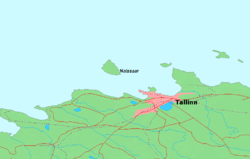User:JovianArchiver/Soviet Republic of Naissaar
Soviet Republic of Soldiers and Fortress-Builders of Naissar Советская республика матросов и строителей | |||||||||
|---|---|---|---|---|---|---|---|---|---|
| 1917-1918 | |||||||||
|
Flag | |||||||||
 Map of Naissaar and Tallinn | |||||||||
| Capital | Naissaar | ||||||||
| Common languages | Russian, Estonian | ||||||||
| Government | Soviet Republic | ||||||||
| Historical era | Russian Civil War | ||||||||
• Established | 25 December 1917 | ||||||||
• Disestablished | 26 Feberuary 1918 | ||||||||
| Area | |||||||||
| 1918 | 18.56 km2 (7.17 sq mi) | ||||||||
| Population | |||||||||
• 1918 | 300 | ||||||||
| |||||||||
The Soviet Republic of the Soldiers and Fortress-builders of Naissar (Estonian: Naissaare Nõukogude Vabariik; Russian: Советская республика матросов и строителей o Советская республика Найссаара) was a short-lived Soviet Republic established on the island of Naissar Naissaar (German: Nargen; Swedish: Nargö) on December 17th 1917 and led by Stepan Petrichenko, until the garrison was evacuated to Kronstadt on February 26th 1918.
History
[edit]The Ukrainian anarcho-syndicalist Stepan Petrichenko was taken into the Russian navy in 1913 and assigned to the battleship Petropavlovsk. During the February Revolution the ship was based on Naissaar, which had been emptied of its inhabitants in 1914. The Russians built a new fort on the island during the First World War, stationing 80-90 sailors there.[1] Estonia acquired some autonomy in April 1917 by a decree of the Russian provisional government, though Estonia remained under the suzerainty of the Russian Empire. However, after the October Revolution the Bolshevik rebels suspended Estonia's provisional government, the Maapäev. A local Council of Workers and Soldiers' Ambassadors convened on Naissaar, declaring the local People's Commissar Council on 17 December, which included the Commissioner for War, Home Affairs, Labor, Finance and Health; they were later joined by an Education Commissioner. Petrichenko was elected Chairman of the Council.[2] The Council declared: "In constitutional terms, Naissaar has been designed to be an independent Soviet republic", naming it the Soviet Republic of Soldiers and Fortress-Builders of Naissaar.[3]
The Council began drafting a constitution, the capital was designated the Southern Village and the anthem "The Internationale". The flag became the red-black flag of anarcho-syndicalism. It was also intended to issue its own money, but the name of the units is unknown.[2] The Soviet Republic of Naissaar was also recognized, at least de facto, by the workers' government in mainland Estonia, who sent prisoners to the island "to fortify some of the castles, clear the railroads, carry snow and dig sand."[3]
At this point the newly formed Estonian Provisional Government appealed to the German army for assistance. The Republic fought both the Bolsheviks and the Germans alike. However, after German forces occupied the island on February 26, 1918, the Baltic fleet evacuated most of its population, moving towards Helsinki and then to Kronstadt. Thus the "soviet republic" ceased to exist.[2] The few remaining people were imprisoned in the harbor barracks, and military buildings were destroyed. However, some of the sites were rescued by a local forest ranger who disconnected wires to the explosives.[3] A week later, the Bolsheviks ceded the Baltics to the German Empire, in the Treaty of Brest-Litovsk. Stepan Petrichenko became widely known in 1921, as the leader of the Kronstadt uprising against the Bolsheviks, after which he fled to Finland.[2]
The Estonian government executed forty Bolshevik prisoners of war here in February 1919.[4] As the result of the German revolution and capitulation of Germany in World War I,[5] the German occupiers handed over rule of Naissaar to the Estonian Provisional Government on 19 November 1918. After the Estonian Constituent Assembly met on April 23, 1919, and the first elected government of the Republic of Estonia took office, the Estonian Provisional Government resigned on May 8, 1919.[6] The island then became part of the new Estonian Republic in 1920.
References
[edit]- ^ "Jalutuskäik saladusliku Naissaare lõunarajal". Eesti Loodus (in Estonian). Retrieved 2007-10-24.
- ^ a b c d "Naissaar: The Estonian "Island of Women" Once an Independent Socialist Republic". Retrieved 2018-03-18.
- ^ a b c "Naissaare kroonika" (in Estonian). Archived from the original on 2005-03-06. Retrieved 2007-10-24.: "nõukogu kuulutab saare soldatite ja kindluseehitajate sotsialistlikuks vabariigiks."
- ^ Kasekamp, Andres (2000). The Radical Right in Interwar Estonia. Macmillan. ISBN 978-0-312-22598-8.
- ^ Kortmann, C.; J. Fleuren (2004). Constitutional Law of 10 EU Member States. Kluwer. ISBN 978-90-13-03468-4.
- ^ Jackson, Battle of the Baltic, page 9
See Also
[edit]Further Reading
[edit]

